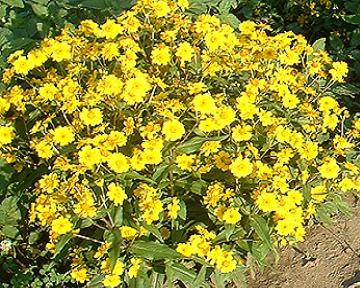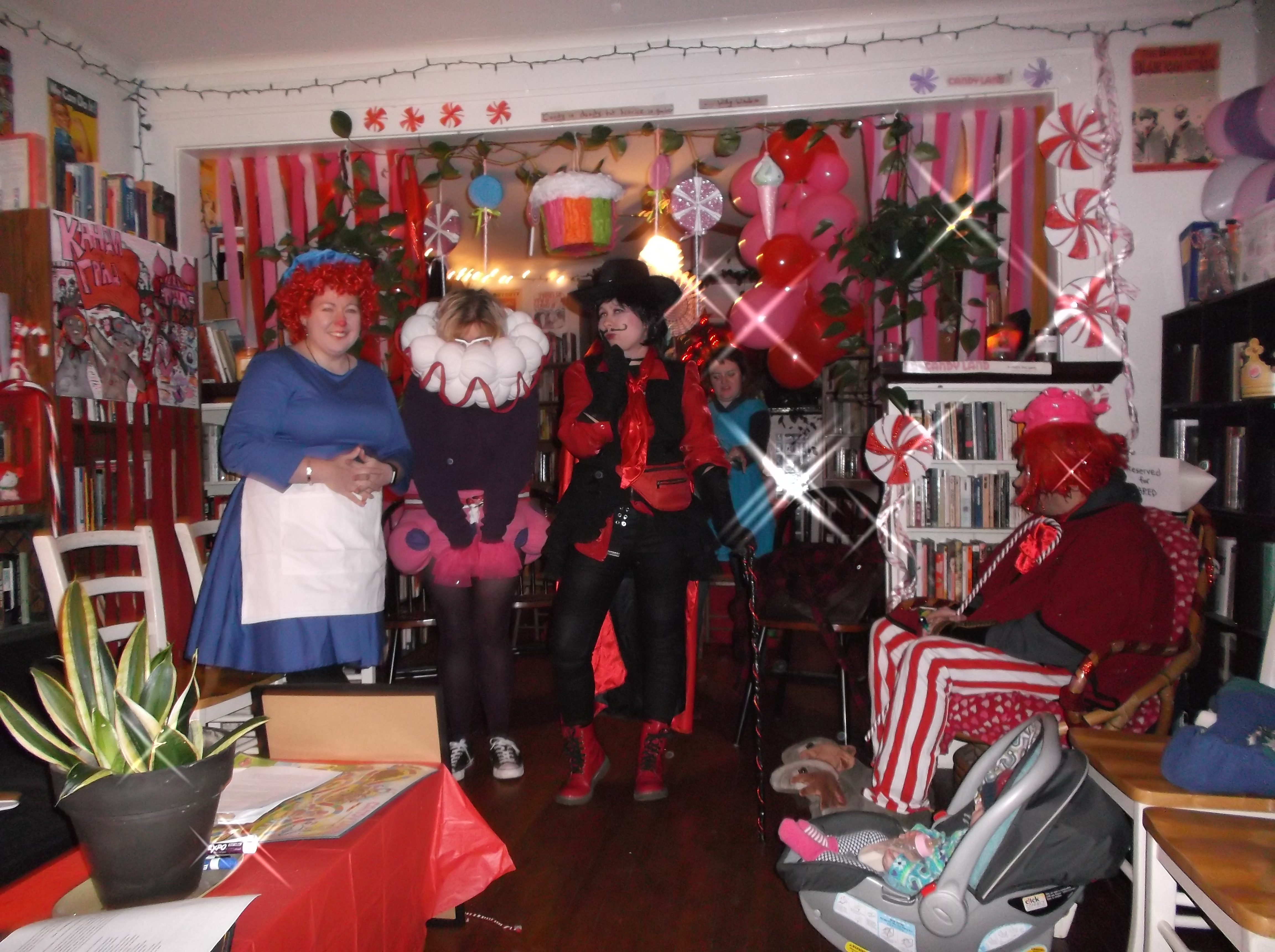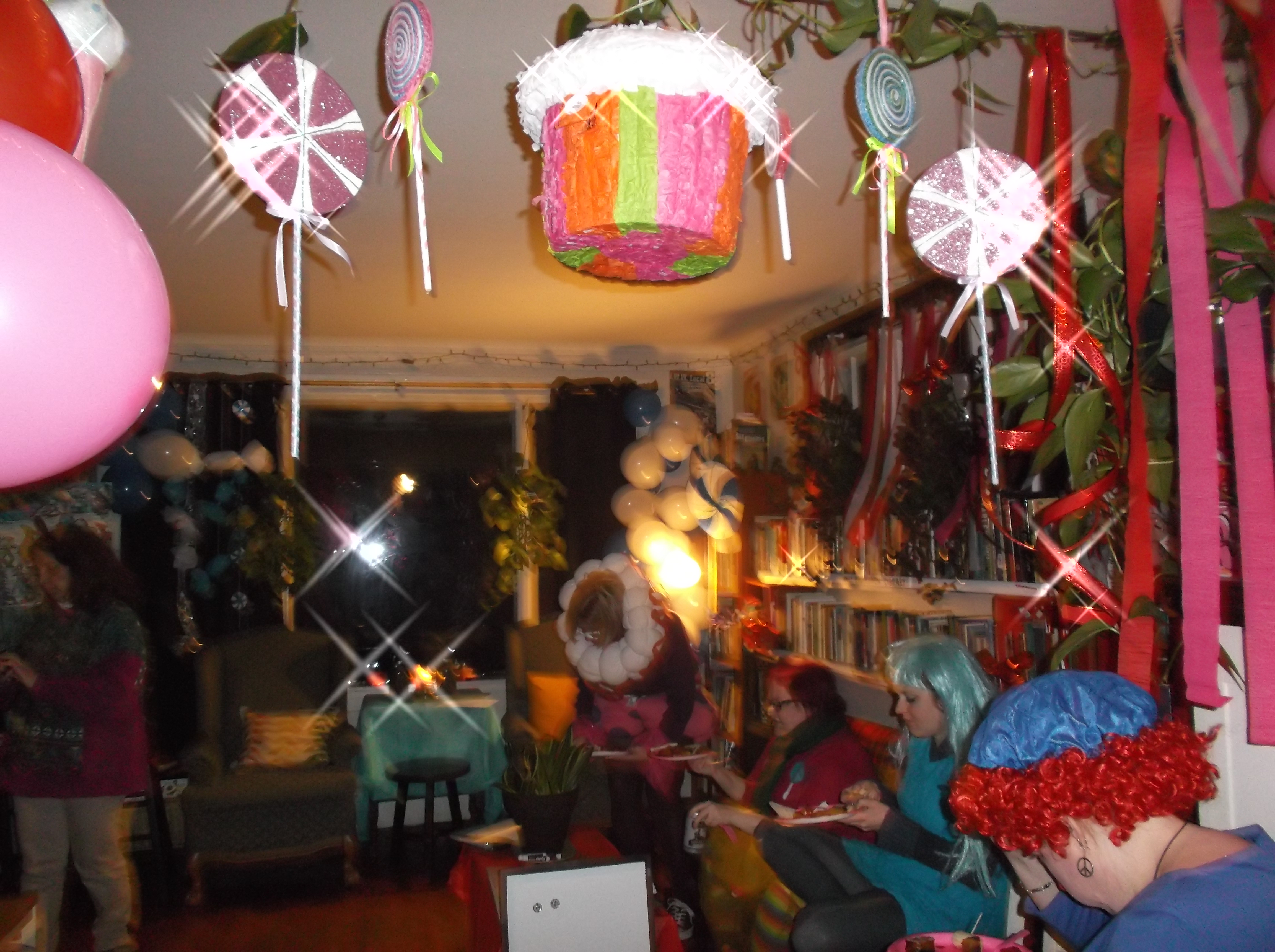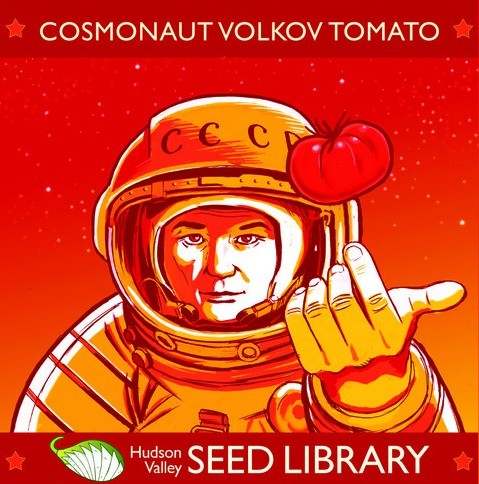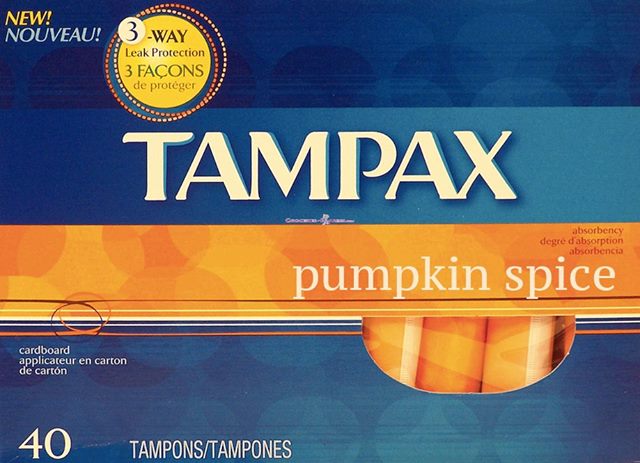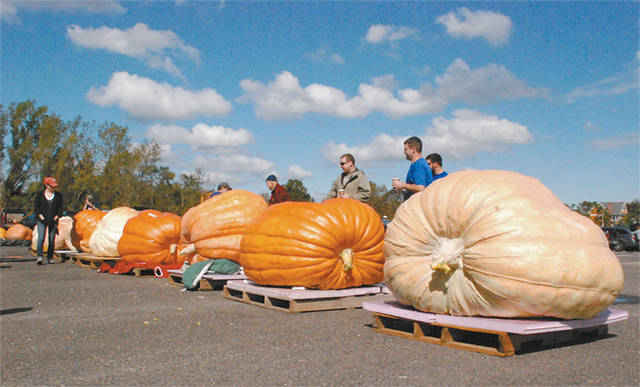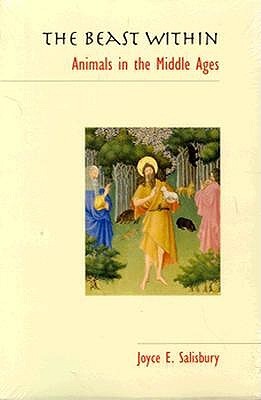Fungi and Feminism
H. Bradford
8/12/17
Once a month, the Feminist Justice League hosts a feminist frolic. This month, the goal was to go on a hike to learn more about fungi, edible and otherwise. We asked Ariel, one of our members, if she would be willing to tell us a little about edible fungi, as she forages for fungi and sells them to a local grocery store. As for myself, I undertook the task of trying to connect fungi with feminism for a short presentation on that topic. Connections between these two topics are not commonly made, but almost anything can be connected to feminism. Indeed, fungi can be connected to feminism through an exploration of women’s roles as foragers and food preparers, the connection between fungi and witchcraft, and the contributions women have made to mycology, the science of fungi.
An Introduction to Fungi:
To begin, it is useful to outline some basic information about fungi. Fungi are a diverse group of organisms that consist of everything from yeast in bread and beer, infections like athlete’s foot or ringworm, mushrooms and toadstools, and mold on bread. Most people are probably most familiar with fungi in the form of mushrooms, the fruiting bodies of some fungi. However, this is just a small portion of the diversity of this kingdom. Taxonomy is always changing, but fungi are often considered to be one of five or six kingdoms of organisms, including plants, animals, protists, archaebacteria, fungi, and bacteria. For most of history, fungi was lumped into the plant kingdom and it was not until the 1960s that they were separated into their own category of lifeforms. It might be easy to confuse fungi with plants, due the fact that both grow in soil and tend to be stationary. In actuality, fungi was more closely related to animals and 1.1 billion years ago they shared a common evolutionary ancestor with the animal kingdom (Staughton, 2002). Fungi are similar to animals in that they cannot produce their own food, as plants do through photosynthesis. Rather, they feed on dead and living organisms, breaking them down by excreting enzymes and absorbing nutrients through their cell wall (Fungi-an introduction, 2009). This means that they differ from animals in that they do not ingest their food, rather they absorb it. Another similarity between animals and fungi is that both of them use oxygen in cellular respiration to convert nutrients into energy. That is, both use oxygen and release carbon dioxide as waste, as opposed to plants which use carbon dioxide and release oxygen (Bone, 2011). Yet, fungi are similar to plants in that both have cell walls, although the cell wall of plants is made of cellulose and the cell wall of fungi is made of chitin. Chitin is the same substance that the beaks of squids and the exoskeletons of crustaceans and insects is made of.

Despite the clear differences between plants and fungi, historically, fungi have been lumped together with plants and even today, mycology tends to be lumped within botany departments rather than zoology. While fungi have had a sort of identity crisis over history, they do indeed have a very close relationship to plants. Over 90% of all plants have a mycorrhizal fungal partner. In other words, plants often have fungi that live on or in their roots for the purpose of helping them extract more nutrients from the soil. In exchange, the fungi obtain sugar, which the plant produces. This is why a person often sees mushrooms at the base of trees. Some unusual plants, such as monotropes (more commonly known as Indian Pipe or Ghost Plant), do not produce chlorophyll and depend upon fungi to obtain energy from nearby trees. Almost every plant has fungi living between their cells. In addition, 85% of all plant disease are caused by fungi. In fact, chili peppers evolved their hotness as a defense against fungi (Bone, 2011). Therefore, it is no wonder that plants and fungi are associated with one another.

One of the most interesting thing about fungi is how diverse that kingdom is. While the animal kingdom contains a wide array of organisms including lifeforms as different as horseflies, sea horses, horseshoe crabs, and horses fungi vary even more greatly. Fungi include organisms that reproduce sexually, asexually, and both. This makes them extremely interesting from a sexual standpoint. Unlike animals, they can be one celled or made up of many cells. Subsequently, fungi include such diverse phylums as club fungi, which include mushrooms, toadstools, puffballs, and shelf fungi. This is the phylum that most people are probably familiar with. These fungi often have club shaped structures with gills containing spores. Another phylum of fungi are called sac fungi, or fungi which produce spores in tiny sacks. This group includes yeast, truffles, molds, and morels. Another phylla is called zygomycota, which feature sexual and asexual reproduction and include black mold. Finally, there are imperfect fungi, which have unknown methods of reproduction and include penicillium and aspergillus. There are about 1.5 million species of fungi, but only one tenth of these are known to science. Interestingly, the mass of the world’s fungi is far greater than the mass of all of the world’s animals, amounting to about ¼ of the world’s entire biomass (Fungi-an introduction, 2009). Fungi also outnumber plants six to one. Finally, the largest organism on the planet is actually a honey fungus in Oregon which is over 2,400 years old and larger than 1,666 football fields (Bone, 2011). Truly, fungi among the most fascinating forms of life on the planet.

Mushrooms, Women, and Foraging:
For most of history, fungi were not given much attention as a unique group of organisms. Thus, most early humans would have understood fungi mostly through the sexual phase or the fruiting body of a mushroom (Garibay-Orijel, Ramírez-Terrazo, and Ordaz-Velázquez, 2012). Humanity’s earliest encounters with fungi would have been with mushrooms and shelf fungi. Humans lived as hunters and gatherers, in small communities that foraged for their food, for 190,000 of our 200,000 years as modern humans. Some human societies continue to live this way. For most of human history, humans foraged for fungi, for food, medicine, ritual, dyes, etc. However, mushroom foraging is confounded by the fact that mushrooms may appear only at certain times of the year or under certain conditions. They may not appear in the same place each year, making them harder to forage than plants. Mushroom foraging is also made difficult by the fact that some mushrooms are extremely toxic, which means that misidentification or experimentation could result in illness or death. Around 2,800 species of mushrooms are used today by humans. Much of the mushroom foraging in the world is done by women (Garibay-Orijel, Ramírez-Terrazo, and Ordaz-Velázquez, 2012). This comes a little surprise, as in a study of 175 modern hunter-gatherer societies, women provided four fifths of the food. According to Crane’s research (2000) the food that was typically gathered by men was further away and harder to obtain. Today, in Mexico, Bahrain, Guatemala, Guyana, Nigeria, Zaire, Southeast Asia, Australia, and Russia, mushroom foraging is largely women’s work. However, in Poland and Switzerland, is is more often done by men. In some tropical areas, women collect mushrooms closest to their homes whereas men collect mushrooms that are deeper in the forest (Garibay-Orijel, Ramírez-Terrazo, & Ordaz-Velázquez, 2012). This is not unlike the gender dynamics of collecting honey and may reflect the importance of women in society for their reproductive capacity (Crane, 2000). In Guyana, men pick up mushrooms that they find incidentally on hunting trips, whereas women engage in active, premeditated mushroom collecting. Beyond this, there are gendered ways in which mushrooms are collected, with men tending to be solitary foragers who search out more valuable and hard to find mushrooms and women collecting them together and in more energy efficient locations. Mushrooms that are collected for ritual purposes are often done by both genders. Mazatec healers in Mexico can be women or men and Maria Sabina was an important informant of mushroom rituals to ethnographers (Garibay-Orijel, Ramírez-Terrazo, and Ordaz-Velázquez (2012).

While it seems that among many hunting and gathering cultural groups women play an important role in obtaining mushrooms, this is not the experience in industrial United States. Bone (2011) found that many of the people she encountered while foraging for mushrooms were men. Professional mushroom foragers, who often travelled the country in search of various mushrooms, were often men. In particular, men from Mexico and Southeast Asia made a living by foraging and selling mushrooms. At the same time, even amateur or more casual mushroom foragers were men. When she sought to learn more about foraging mushrooms, it was always men who shared their expertise. She also noticed a certain machismo among mushroom foragers, as some took risks by eating mushrooms that were known to be toxic or have negative health effects. Bone (2011) was focused on developing her knowledge of mycology and experiencing fungi from the perspective of a foodie. Her book, Mycophilia, does not examine the gender dynamics of mushroom foraging at any length. However, it does very clearly support the idea that in the United States, mushroom science, foraging, commercial production, and preparation are all largely dominated by men. This begs the question of why mushrooms exist so differently from the women centered foraging that is prevalent elsewhere in the world and presumably elsewhere in history.
There may be a few explanations for their phenomenon. For instance, until the 1600s in France, mushroom foraging was women’s work. However, with the scientific revolution, mushrooming became a men’s activity as men began to monopolize the science of mycology (Dugan, 2008). The shift from mushroom foraging as women’s work to men’s work represents a shift of the power of behind which knowledge is given privilege in society. As men took control of institutions of learning, medicine, publishing, science, etc. and systematized scientific knowledge, the folk knowledge of women, but also poor people, indigenous people, criminals, people with disabilities, and other marginalized groups was denigrated, ignored, or suppressed. This might explain why according to Dugan (2008) mushroom collecting was mainly conducted by women in the United States until the 19th century. In was during the 19th century in the United States that women’s knowledge of childbirth, medicine, and the natural world in general was suppressed by emergent medical and professional institutions. As this knowledge was professionalized and monopolized, the knowledge of men was empowered and given social value at the expense of women. Long before the advent of science, many groups of people developed the a body of knowledge about mushrooms that scientists would only later rediscover. For instance, Russian peasants had a deep knowledge of mushrooms and some of the common names for these mushrooms were associated with the tree that the mushrooms grew near. Europeans were latecomers to mushroom identification and even Darwin was indifferent to fungi when writing about evolution. However, the Mayans developed their own system of classifying mushrooms, as did the Chinese. Chen Jen-yu’s Mycoflora, written in 1245, proposed 12 types of mushrooms (Dugan, 2008). In all, this should illustrate that humans have had thousands of years of interactions with fungi and through use and observation developed a body of knowledge. Some of this knowledge was dismissed or overlooked on racist, sexist, and classist grounds.

Mushroom hunting- a painting by Bernardina Midderigh Bokhorst
The ability of women to forage for mushrooms is also challenged by capitalism. Capitalism negatively impacts women more than men, because women are oppressed as workers and on account of their gender in capitalism. The oppression of women include the being paid less than men, doing more unpaid labor in the home, experiencing sexual harassment and sexual assault, having limited reproductive freedom, enjoying less political representation, having less social legitimacy, and a myriad of other expressions of oppression. Thus, at least on the amateur end of mushroom collecting, women may not be as involved because of the ways in which capitalism and patriarchy shape women’s relationship to nature. Within the United States, time in nature is usually associated with leisure, which women have less of due to spending more time with care work and household work. Women are often also economically dependent upon men and make less money than them, which may mean that taking up hobbies and traveling around to pursue them is a greater economic burden. Within the context of societies which are less developed and women continue to forage for mushrooms, women have a harder time obtaining wage labor, surviving on lower wages, and supporting their families. In some areas of the world, foraging and selling mushrooms to middle men is an important way that widows and single mothers generate income for themselves. Historically, women sold vegetables and mushrooms in markets in Europe. This tradition conditions in Eastern European countries like Latvia, Russia, Bulgaria, Lithuania, and the Czech Republic, where women are often the source of mushrooms in markets (Garibay-Orijel, Ramírez-Terrazo, and Ordaz-Velázquez, 2012). Therefore, mushroom foraging is an important source of income to women. Because it is work that is outside of the formal economy, they are more vulnerable to difficult labor conditions. And, because of the environmental problems wrought by more developed countries in the context of capitalism, women are vulnerable as the environment they depend upon for livelihood is threatened. For instance, women in Puebla Mexico must obtain permits to go into the forest and collect mushrooms. In other places, such as Burundi, logging has diminished the abundance of mushrooms. Another challenge is other ecological issues, such as acid rain and soil nitrification in Europe. Mushroom collectors are often independent workers, so they are not afforded health or safety benefits (Garibay-Orijel, Ramírez-Terrazo, and Ordaz-Velázquez, 2012). Indeed, mushroom yields around the world have decreased over the years, perhaps as a result of climate change.
Women and Food:
Closely related to foraging, women are engaged in cooking and eating fungi. The preparation of mushrooms, including cooking and storing, is mostly done by women around the world (Garibay-Orijel, Ramírez-Terrazo, and Ordaz-Velázquez,2012). According to the Bureau of Labor Statistics, in an average day, American women spend about twice as much time as men preparing food and drinks. In an average day, 70% of women reported preparing food compared to 43% of men. This means that women not only do more food preparation than men, more women are engaged in this activity than men (Charts by Topic: Household activities, 2016). This should come as little surprise to feminists, who have long articulated that women do more unpaid household labor than men. This work is often devalued, taken advantage of, and taken for granted as part of the normal gender roles and relationship between men and women. Although women do more unpaid cooking, men dominate professional cooking. Women and men attend culinary school in equal proportions, but most celebrity chefs and paid culinary professionals are men. Men also outnumber women 7 to 3 at more prestigious culinary schools and when women do go into culinary arts, they are disproportionately represented upon baking and pastry programs (Jones, 2009). For instance, at B.A program in pastries at the American Culinary Institute is made up of 86% women (Tanner 2010). Both of these trends represent how “women’s work” is undervalued in society. At culinary schools, pastry sections are called the “pink ghetto” or “pink section” because they are dominated by women. Food and work are both gendered in society. Baking and desserts are associated with femininity (Brones, 2015). This relationship to cooking also creates a special relationship to fungi, even if this relationship is not immediately obvious.

The first relationship to fungi is the relationship between women and yeast. To begin, bread of some kind or another has been eaten by humans for at least 30,000 years. But, early breads were unleavened flat breads which were made from ingredients other than grains. The first recorded discovery of yeast is from Ancient Egypt, where yeast was used to leaven bread and make beer 6000 years ago. No one knows how yeast was discovered. It may have been floating in the air and landed in some bread, resulting in lighter, fluffier bread. Or, it is possible that yeast entered bread by adding ale to it instead of water. In any event, the discovery of yeast necessarily coincided with several other developments in human history. First of all, it arose out of settled societies which domesticated and grew grains. Grains were domesticated by ancient farming civilizations about 8000 years ago. But, for most of human history, people foraged for their food. Settled agriculture allowed for population growth, the birth of cities, the invention of written languages, private property, and social stratification. It also is considered to be the beginning of patriarchy, as with the invention of private property, monogamy and the associated control of women was ensured the transmission of property through sons. Settled agricultural societies were possible because of a surplus of food. This surplus of food also allowed for the creation of professions, thus, in Egypt, there were professional bakers, herders, teachers, doctors, scribes, etc. Egyptian art depicts both men and women engaged in bread making. However, it is more likely that men were involved in the actual profession of bread making or baking, while women made bread in the home or as supporters. This gendered dynamic continued through time. For instance, in Medieval Europe, women prepared food for their families or homes, whereas men were professional breadmakers in guilds. In both examples, the work of women was essential the same, but not given the same social value. So, although women are more likely to work with yeast or for that matter cook with any other fungi, it is not seen as work that matters in the same way professional culinary work matters.

While women have a close relationship to food and by extension, fungi as a food, due to their role as a cook for their families, this often goes unnoticed or unheralded. Despite gender inequalities, women managed to influence society through cuisine. For instance, countries can roughly be divided into mycophobic and mycophilliac depending upon their relationship to mushrooms. France is viewed as a mycophiliac culture, with many recipes calling for mushrooms and a history of foraging for mushrooms. It was largely through women that this French passion for mushrooms spread to other countries. For instance, Hannah Glasse wrote an English cookbook in 1747 which drew from French cuisine and included 110 mushroom recipes called the Art of Cookery Made Easy. Eliza Action’s cookbook Modern Cookery for Private Families (1845) and Mrs Beeton’s Book of Household Management (1861) also included dozens of mushroom recipes. Cookbooks focused on the historical cuisine of the British isles tended to have few mushroom recipes. The first American cookbook, by Amelia Simmons in 1796, does not feature any mushroom recipes. But, by the 1800s, various cookbooks featured mushroom dishes. Campbell’s Cream of Mushroom Soup, introduced in 1934, popularized mushrooms as part of American casserole cuisine. And, one of the most popular American cookbooks of the 20th century, Julia Child’s Mastering the Art of French Cooking (1961) included dozens of mushroom recipes. Irma Rambauer’s book The Joy of Cooking included 30 recipes with mushrooms (Bertelsen, 2013 ). In each of these examples, women were able to influence culture by working within the traditional social space offered to women. The household has traditionally been viewed as the sphere of influence of women. Books about cooking, by women for women, is a way that women exerted power within the confines of tradition. In doing so, in a small way, these cultures were changed. Today, mushrooms consumption has exploded. The global export value of mushrooms was almost 1.75 billion dollars in 2010, compared to 250 million dollars in 1990 and negligible in 1970.

Another way in which women relate to fungi is through the ways that food is gendered in society. Because mushrooms are a viewed as a vegetable and something healthy, one might assume that women eat more mushrooms than men. After all, women are told to watch their weight, monitor their food intake, and make healthy food choices. At the same time, masculinity is connected to meat eating. Eating mushrooms seems to be something lowly and feminine. There is even a racial and ethnic component to eating mushrooms, as they are associated with mycophilliac cultures such as India, China, Japan, and Russia. Surprisingly, men and women in the United States actually eat roughly the same amount of mushrooms each year. According to the USDA, women consume about 8% more fresh mushrooms then men, but men are more likely to eat processed mushrooms. As a whole, men ate about 49% of all mushrooms produced in the United States, whereas women ate about 51% (Lucier, Allhouse, and Lin, 2003). Yet, this isn’t to argue that gender does not shape mushroom consumption. In Mycophilia, Eugenia Bone, a food writer from New York, expressed disdain when she attended a Midwest mushroom foraging event and the men in attendance planned on battering their mushrooms or putting them on steaks (Bone, 2011). In this example, gender, geography, and class intersected to generate a different sense of taste from the Midwestern men with less social capital. In another example, the white truffle is the most expensive food in the world, at $3000 per pound (Bone, 2011). However, men with power are more likely to obtain and ingest truffles. For instance, a 3.3 pound truffle was auctioned for $330,000 to a billionaire named Stanley Ho, a Macau casino owner. The truffle itself was discovered by an Italian truffle hunter and his father, along with their dog. Gordon Wu, a property tycoon from Hong Kong purchased two truffles at an auction for 125,000 euros. An anonymous Chinese writer purchased a truffle for $120,000 at an auction. Globally, women and children are more likely to be among the world’s poor and less represented among the super wealthy. The truffle’s value is because it is hard to successfully commercially cultivate, rare, and labor intensive. At the same time, some its value is more symbolic than material, as truffles are abundant in China, where labor is cheap enough (i.e exploited) that they are raked from the earth by humans rather than trained dogs and pigs. But, these black truffles are viewed as inferior to European black truffles. In this sense, when food is associated with power and privilege, women are less likely to partake in this indulgence. So, while men and women may eat equal amounts of mushrooms, how they are eaten may differ. I would hypothesize that men eat them more often on pizza, battered, on burgers, or on steaks and women in salads and as a meat substitute. Class certainly shapes mushroom consumption as well, not only in access to elite foods like truffles, but in consumption of mushrooms in general. Bone (2011) noted that the biggest consumers of mushrooms were those who were 350% above the poverty line.

(image stolen from National Geographic…)
Mushrooms, Women, and Witchcraft
Another way in which mushrooms have been associated with women is through medicine and witchcraft. In Europe, mushrooms have often been associated with mushiness and evil. French words for mushrooms translate to eggs of the devil, devil’s paintbrush, and toad bread. Toadstool and toad hat are names derived from Danish mushrooms. In Estonia, Fulgio septica, a large yellow slime mold is called “Shit of a Witch (Dugan, 2008).” An edible yellow fungus commonly found on dead branches is called “Witches butter.” Western Europe and the British Isles in particular associated mushrooms with witchcraft (Bertelsen, 2013). In Russia, Baba Yaga is associated with magical tree mushrooms. In one story she spares the life of a hedgehog that is eating a mushroom, under the understanding that the hedgehog will become a boy and serve her. She is also accompanied by spirits that live under mushrooms. In Italy, there is a story of a witch who disguised herself as a mushroom to figure out who is stealing her cabbages. Mushrooms have been associated with fairies and in 1599, the word fairy ring described, which is a ring of mushroom left behind by dancing fairies. In Germany, fairy rings were known as Hexen rings, where witches would dance in a circle on Walpurgis night or the night before May Day (Dugan, 2008). Plant diseases caused by fungi were sometimes believed to be caused by witches, as exemplified by a decree by Pope Innocent the VIII who noted that witches cause crop failure. Witches were also blamed for the poisoning of cattle, which itself was often the cause of grain fungi. Witches were believed to use fungi in herbalism, and that least Inquisition documents indicate the beliefs that witches used puffballs in potions in Basque country, Amanita Muscaria is known as “Witches mushroom” in Austria, and witches in Portugal used a hallucinogenic mushroom called Panaeolus papilionaceus. There is also a Finnish belief that if someone is bothered by a kobald like creature, a certain species of mushroom was fried in tar, salt, and sulfur, then beaten, and the woman who controls the kobald would appear to release the creature. In the Balkans, dried mushrooms were used to ward of witches by placing them in the windowsill (Dugan, 2008). It seems that mushrooms have been associated with witches, mischief, powerful women, and misfortune. Though, there are some exceptions. For example, in China, the lingzhi mushroom or mushroom of immortality, was associated with Kuan Yin, the goddess of healing and mercy (Bertelsen, 2013).

(Witches Butter Fungus- Image from Birds and Blooms)
There may be some actual connections between witchcraft and fungi. For instance, there is a connection between ergotism and witch trials. Ergotism is caused by the grain fungi, Claviceps purpurea. The fungus colonizes cereal crops, producing nectar like droplets containing spores. The disease is called ergot, the French word for spur, due to the rooster spur like shape of the fungus on the infected plant. In medieval times, up to 30% of the harvested grain was actually fungus, due to wet weather conditions. When humans or animals ingest the fungus many symptoms can arise. The infected can feel intense heat over their body and lose blood flow to their extremities, causing the limbs to rot and fall off. This condition was called St. Anthony’s Fire due to these symptoms. The alkaloids produced by the fungus can also cause vomiting, diarrhea, the sensation of ants on the body, twitching, hallucinations, seizures, and distortions of the limbs. Ergotism outbreaks occurred through the 1800s. Peasants were vulnerable as they had to eat lower quality grain or could not waste the diseased grain. Children were particularly vulnerable with 56% mortality in some outbreaks. Historians such as Mary Matossian have hypothesized that witch trials and bewitching may have actually been the result of ergotism. She argued that most witch trials happened in river valleys in southwest Germany and south east France, where cool and wet conditions would have promoted fungal growth. Both places grew rye and peasants in the area would have consumed up to three and a half pounds of bread a day. There was only one witch trials in Ireland, where grain was not grown as much. Trials for witches often happened in the fall or winter following wet years. Even the Salem Witch Trial followed this pattern as it occurred after a cool spring. The symptoms reported in the witch trials were similar to ergotism and the fact that children reported these symptoms is also consistent with the fact that children are more vulnerable to the effects of ergotism. It is interesting to note that in studying ergot grain fungi, Albert Hofman developed LSD (Hudler, 2000). In any event, it is possible that outbreaks of ergotism were blamed on witches and a catalyst for witch hunts.

(A vintage Halloween postcard featuring a costumed witch with fungi)
Beyond this association with witch trials, it is useful to dissect what a witch is. A witch is symbolic for a women with power and knowledge. For thousands of years, humans obtained an immense amount of knowledge from the natural world in terms of edible foods, useful medicines, dyes, animal movements, etc. Because women had an important role in gathering foods, they had special knowledge. Further, prior to the invention of patriarchy, women likely had important roles as religious or spiritual leaders, healers, and religions with goddesses. Over time, with changes in social structures and the introduction of Christianity, the role of women was diminished and their knowledge was viewed as threatening and connected to paganism. In this way, the idea of a witch is a way to diminish and persecute the traditional knowledge and roles of women. Witches may be associated with mushrooms because of how mushrooms were used in healing and rituals. Indeed, some fungi have healing properties. Mushrooms are valued in Chinese cuisine, culture, and medicine. Chinese medicine includes 100 species of mushrooms, including the wood ear mushroom which was eaten for its perceived improvement to circulation and breathing. The health effects of mushrooms are only recently being discovered in the West. Mushrooms contain polysaccharides, which boost the immune system and can be a source of protein, potassium, riboflavin, niacin, vitamin D, copper, and selenium. Chanterelle mushrooms are 11 to 24% protein. In contrast, the average potato contains 3.9% protein. Mushrooms also secrete antibiotics (Bertelsen, 2013). The most famous fungal cure is penicllin, but fungi are used in many modern medicines. Beano is made with the fungi Aspergillis niger, which digests methane and in turn relieves flatulence. Lovastatin and Pravastatin are both derived from fungi and used to treat high cholesterol. Cyclosporin comes from a fungus and is used to suppresses the immune system for organ transplants. Shiitake mushrooms may have cancer fighting properties (Hudler, 2000). Gypsy mushroom may be effective against herpes, the steroids used in birth control come from fungi, turkey tail mushroom may be a treatment against hepatitis C, and fomitopsis officinalis has been used to treat tuberculosis and e-coli. Midwives in Germany and Italy used ergot, the deadly grain fungus, to induce labor (Bone, 2011). Mold was used by Chinese, Ancient Egyptians, and French to treat wounds (Hudler, 2000). Of course, the benefits of fungi should not be overstated. They may be hard to digest due to their chitin cell wall. Some fungi are deadly. Designating fungi as a superfood is a marketing ploy to sell more mushrooms. However, the healing properties of many mushrooms may mean that witches were associated with mushrooms because healers traditionally used mushrooms as medicine. By associating healing with evil and witchcraft, women’s knowledge, experience, and power was de-legitimized. At the same time, through witch hunts and trial, women themselves were terrorized with violence and the threat of violence as a form of social control.

Women and Mycology
It should be clear that one of the themes related to women and fungi relates to the value of the knowledge and work of women in society. It is suiting then that the final point is how women have contributed to the science of mycology. In this feminist narrative of history, women have probably been closely connected to fungi for most of human history as foragers for food and as healers. With the end of hunting and gathering societies in many parts of the world, women took on new, but subservient roles in society. Still, women continued to be connected to fungi through their preparation of food and role as caregivers, even if this labor was not given social importance. This final segment of history is about women struggling to assert themselves in male dominated science. Outside of the realm of formal science, women are often responsible for passing down knowledge of mushrooms to their children. Even the science of mycology depending upon the knowledge of women. For instance, Carolus Clusius and Franciscus van Sterbeeck, who lived in the sixteenth and seventeenth century, respectively were two of the the first pioneers in mycology. These men relied upon the knowledge of wise women, known as herb wives, to obtain information about mushrooms (Garibay-Orijel, Ramírez-Terrazo, and Ordaz-Velázquez, 2012). It is tragically ironic that when men were developing science based upon the knowledge of women, these very same women were persecuted as witches for their knowledge of nature.
Later in history, Mary Elizabeth Banning was a pioneer in mycology who sought to identify mushrooms in the 1800s (Bertelsen, 2013). She identified 23 new species of fungi and completed one of the first guides to mushrooms of the New World. She worked as a teacher to support her mother and sisters after her father died, but found time to pursue mycology, then associated with botany. Men dominated professional botany, but women were sometimes amateur botanists. For 20 years, she studied the mushrooms of her home state of Maryland at a time when there was only one book on American fungi. She never earned money or recognition and was often viewed as a lunatic by those outside of the scientific community. She did however correspond by mail with various scientists (Pugliosi, 2016). Her life represents several barriers for women who wish to pursue science. For one, she was burdened with care work for her family. Her mushrooming adventures were limited by the constraints of caring for her family. At the same time, her work was stymied by the fact that she also had to be a wage laborer as a teacher. Her “hobby” as a scientist was an unpaid third shift. While she produced useful information, she never published it out of lack of confidence and her outsider status to scientific institutions.

(An illustration by Mary Elizabeth Banning)
In a similar but less tragic example, Beatrix Potter was interested in mycology and painted hundreds of scientifically accurate portraits of fungi. She studied fungi under a microscope and presented a paper on fungal spores at the Linnean Society of London. She began creating watercolor paintings of mushrooms at the age of 20 and sent her paintings to the naturalist, Charles McIntosh. In turn, McIntosh gave her scientific advice and sent her specimens to paint. Beatrix Potter also began studying lichens, which she wrongly believed were fungi rather than a symbiotic relationship between fungi, algae, and bacteria. The mycologist, George Murray, rebuffed her, both for the position on lichen and her earlier work on spore germination, which he said had already been studied in Germany decades earlier. Her paper was never published and she was told to make revisions. Female students were not accepted into the society until 1905 and she was unable to present the research herself. Her biggest contribution to mycology was her illustrations, which were used for fungi identification (Flemming, 2016). Potter went on to achieve fame as a children’s book author and illustrator, but her scientific endeavors largely went unnoticed in history. Again, she was shut out of a world controlled by men and men mediated her access and legitimacy within science.

(Mushroom watercolor painting by Beatrix Potter)
With successes of the early women’s rights movement and other social movements, the social space within science slowly expanded for women. In 1950, Elizabeth Hazen and Rachel Fuller Brown discovered Nystatin while trying to isolate antibiotics from Strepomyces noursei (Hudler, 2000). Nystatin was one of the first anti-fungal drugs and is used to treat various Candida infections such as diaper rash, yeast infections, and thrush. Both scientists worked together for the New York Department of Health and went on to develop two antibiotics. Developing anti-fungal drugs is particularly challenging because, as it was noted earlier, fungi are closely related to animals. This makes fungal infections harder to fight than bacterial infections. Bacteria are simpler organisms, with a cell wall but not the complex cellular structures of animals and fungi. This makes it easier to destroy bacteria. Drugs developed to fight fungal infections may attack healthy human cells, as they are more similar (Staughton, 2002).
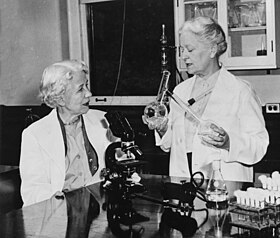
Another contribution to mycology was the discovery of the cause of Dutch Elm Disease, a fungus that destroyed elm trees in Europe and the U.S.. The cause of this disease was discovered by a team of five female Dutch scientists (Hudler, 2000). The source of the devastating tree disease was uncovered in 1921 by a team, lead by Johanna Westerdjik. Westerdjik was a plant pathologist and the first female professor in the Netherlands. She wrote over 70 papers on mycology and plant diseases and supervised over 55 Phd students, half of whom were women. It was her student, Marie Beatriz Schwartz who isolated the fungus infecting elms and another student, Christine Johanna Buisman who developed Dutch Elm Disease resistant elms. The project that she started continued until the 1990s.
“Moldy Mary” was another contributor to mycology. Alexander Fleming discovered penicillin after observing mold attacking bacteria in a petri dish. He hired a woman nicknamed “Moldy Mary” to collect moldy produce so the mold could be studied. Her real name was Mary Hunt and she was a young lab assistant. The molds that Hunt found were tested to determine if they were penicillin. Some of the cantaloupes she collected indeed contained a culture of Penicillium chrysogenum and many modern strains used in modern penicillin come from her moldy melon (Hudler, 2000). Another contributor to knowledge about fungi was Valentina Wasson. Unfortunately, her husband, R. Gordon Wasson is more famous than she is for his research into the cultural relationship between people and mushrooms. However, he was struck by the cultural difference between them when on their honeymoon, Valentina, a Russian, began collecting mushrooms. He was terrified that they were toxic, a reaction that highlighted a difference between his American upbringing and her Russian upbringing and how that shaped their relationship to mushrooms. The incident inspired the couple to research these cultural differences together and they authored Mushrooms, Russia and History in 1957. They went on to travel to Mexico where they studied the relationship to mushrooms among indigenous people and went on to introduce psychoactive mushrooms to a mass American audience through Life magazine (Hudler, 2000). Unfortunately, this attracted droves of Western visitors to the Mazatec community and especially to Maria Sabina, who was interviewed in their book. Maria was investigated by the Mexican police for selling drugs to foreigners and had her house burned down. Thus, while they examined cultural differences in the relationship between cultures and mushrooms, their work had a negative impact on indigenous people of Mexico. Finally, as one last tidbit of mycological history, all button mushrooms, the mushrooms commonly used in pizza, salads, canned mushrooms, and cream of mushroom soup all come from a spore discovered by the Dutch scientist Gerda Fritsche in 1980 (Bone, 2011).

A depiction of “Moldy Mary”
While women have made contributions to mycology over time, gender inequality in mycology persists today. There are two times as many male members of the American Mycological Society as there are females. Only 13% of the presidents of the MSA (founded in 1932) have been female, starting with Marie Farr in 1980. MSA secretaries have been consecutively female since 1991, but treasurers have historically been men. Various MSA awards have also gone disproportionately to men, although female students have won travel grants in greater proportion to their male counterparts. The majority of published articles in Mycologia are written by men (Branco and Vellinga, 2015). Mycology is not unique among the sciences. The gender inequality within mycology is pretty comparable to similar sciences such as botany, ecology, and lichenology. It begs the question of why women do not enter the sciences or when they do, they are not as active in leadership roles.
Oddly enough, I wanted to be a botanist when I was a kid. I even went through a period of time in the 5th grade when I wanted to be a mycologist. I attended science camp and continued to be interested in science through high school. However, I think a deterrent for me and science was a lack of confidence and a fear of math. Low self-esteem is pretty common among girl. There are varying statistics on the occurrence of low self esteem, but if one believes the statistics put forth by Dove’s Self Esteem fund, as many as seven in ten girls believe they are somehow deficient. If girls indeed believe they are not smart enough or capable enough, they may be deterred from science. And, if they do enter the sciences, they still must contend with the social expectations of women, such as having a family, doing research, doing unpaid labor at home, etc. This cuts into time spent for research or going to conferences and limits the ability to become leaders in their field. They may also face sexism and sexual harassment in their work environment, like many women do. Finally, as it has already been outlined, scientific institutions have not been welcoming to women in the past and have suppressed the knowledge of women. Rationality itself is associated with masculinity, whereas femininity associated with emotions. But, rather than viewing one as inferior or that reason and feeling are opposed to each other, they are instead, interconnected. The drive to study the natural world, interest in research, dedication to a subject, and passion for science all come from an emotional place.
Conclusion:
I am certainly not a scientist, but I hope that the presentation and accompanying hike provided a few insights about fungi. Personally, I find fungi pretty fascinating and hope to learn more about them in the future. That is the goal of feminist frolics, to get together, share knowledge, and hopefully open the door to future learning. For thousands of years, the knowledge and experiences of women have not been valued. I think that learning together and sharing builds confidence, community, and self-efficacy. It is also a way to find a place in nature, science, and history. Hopefully you will join the Feminist Justice League in future feminist frolics. I think you will find we are a bunch of fun gals and fungi!

A feminist poster called “Mother Mushroom”
Sources:
Bertelsen, C. D. (2013). Mushroom: a global history. London: Reaktion Books.
Bone, E. (2011). Mycophilia: revelations from the weird world of mushrooms. New York: Rodale.
Branco, S., & Vellinga, E. (2015). Gender Balance in Mycology (Rep.). Retrieved August 12, 2017, from http://msafungi.org/wp-content/uploads/Inoculum/66(5)%20preprint%20gender.pdf
Brones, A. (2015, May 17). Cupcake Feminism: Is What We Bake a Matter of Gender? Retrieved August 12, 2017, from http://www.thekitchn
Charts by Topic: Household activities. (2016, December 22). Retrieved August 12, 2017, from https://www.bls.gov/tus/charts/household.htm
Crane, E. (2000). The world history of beekeeping and honey hunting. London: Duckworth.
Dugan, F. (2008) Fungi, Folkways and Fairy Tales: Mushrooms & Mildews in Stories, Remedies & Rituals, from Oberon to the Internet. North American Fungi, [S.l.], v. 3, p. 23-72, ISSN 1937-786X. Available at: <http://www.pnwfungi.org/index.php/pnwfungi/article/view/1062>. Date accessed: 11 Aug. 2017. doi:http://dx.doi.org/10.2509/naf2008.003.0074.
Fleming, N. (2016, February 15). Earth – Beatrix Potter: Pioneering scientist or passionate amateur? Retrieved August 12, 2017, from http://www.bbc.com/earth/story/20160215-beatrix-potter-pioneering-scientist-or-passionate-amateur
Fungi – an introduction. (2009, October 27). Retrieved August 12, 2017, from https://www.biooekonomie-bw.de/en/articles/dossiers/fungi-an-introduction/
Garibay-Orijel, R., Ramírez-Terrazo, A., & Ordaz-Velázquez, M. (2012). Women care about local knowledge, experiences from ethnomycology. Journal of Ethnobiology and Ethnomedicine, 8, 25. http://doi.org/10.1186/1746-4269-8-25
Hudler, G. W. (2000). Magical mushrooms, mischievous molds. Princeton, NJ: Princeton University Press.
Jones, G. (2009, November 19). Male to Female Ratios in Culinary School. Retrieved August 12, 2017, from https://www.reluctantgourmet.com/male-female-ratios-culinary-school/#context/api/listings/prefilter
Lucier, G., Allhouse, J., & Lin, B. (2003, March). Factors Affecting U.S. Mushroom Consumption (Rep.). Retrieved August 12, 2017, from USDA website: https://www.ers.usda.gov/webdocs/publications/39489/30836_vgs29501_002.pdf?v=41414
Puglionesi, A. (2016, November 08). The Lost Mushroom Masterpiece Unearthed in a Dusty Drawer. Retrieved August 12, 2017, from http://www.atlasobscura.com/articles/the-lost-mushroom-masterpiece-unearthed-in-a-dusty-drawer
Staughton, J. (2016, November 18). How Are Mushrooms More Similar to Humans than Plants? » Science ABC. Retrieved August 12, 2017, from https://www.scienceabc.com/nature/how-are-mushrooms-more-similar-to-humans-than-plants.html
Tanner, P. (2015, February 20). A Debate About The Role Gender Plays in The World of Pastries-www.njmonthly.com. Retrieved August 12, 2017, from https://njmonthly.com/articles/eat-drink/does-dessert-have-a-gender/
Posted in
culture,
feminism,
food,
gender,
history,
outdoors,
Politics/Ideas,
science,
sociology,
Uncategorized and tagged
Duluth,
ergotism and witchcraft,
feminism,
feminism and mycology,
feminist frolic,
Feminist Justice League,
fungi,
H. Bradford,
Heather Bradford,
mushrooms and women,
Superior,
witches and fungi,
witches and mushrooms,
women and foraging,
women and mycology,
women foraging for mushrooms |





































 Perkins: Free Magnificent Seven
Perkins: Free Magnificent Seven

 Marcus Theaters: Soda
Marcus Theaters: Soda


![2[1]](https://brokenwallsandnarratives.files.wordpress.com/2018/06/21.png)
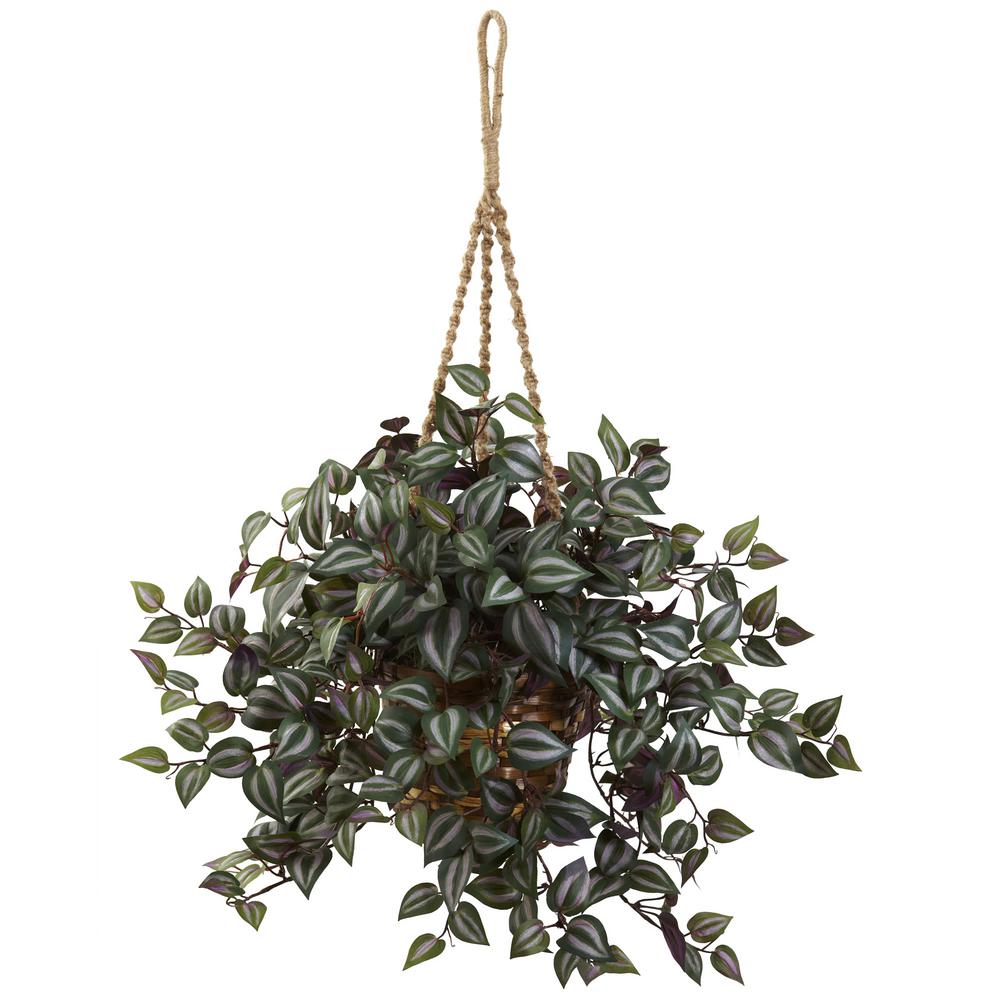 The term Wandering Jew comes from 13th Century Christian folklore. The character is a Jewish man who was said to have taunted Jesus before he was crucified. As punishment for his taunt, he was cursed to walk the Earth until the return of Christ. In some stories, his clothes and shoes never wear out and after 100 years, he returns to being a younger man. He was a perpetual traveler, unable to rest, but able to converse in all of the languages of the world. This is not based on any actual Biblical story, though it may have been inspired by the story of Caine and European paganism. Much like Big Foot or ghosts today, Europeans of the time believed that they had actually seen this character. For hundreds of year, even into the present day, this character has appeared in literature and art.
The term Wandering Jew comes from 13th Century Christian folklore. The character is a Jewish man who was said to have taunted Jesus before he was crucified. As punishment for his taunt, he was cursed to walk the Earth until the return of Christ. In some stories, his clothes and shoes never wear out and after 100 years, he returns to being a younger man. He was a perpetual traveler, unable to rest, but able to converse in all of the languages of the world. This is not based on any actual Biblical story, though it may have been inspired by the story of Caine and European paganism. Much like Big Foot or ghosts today, Europeans of the time believed that they had actually seen this character. For hundreds of year, even into the present day, this character has appeared in literature and art. 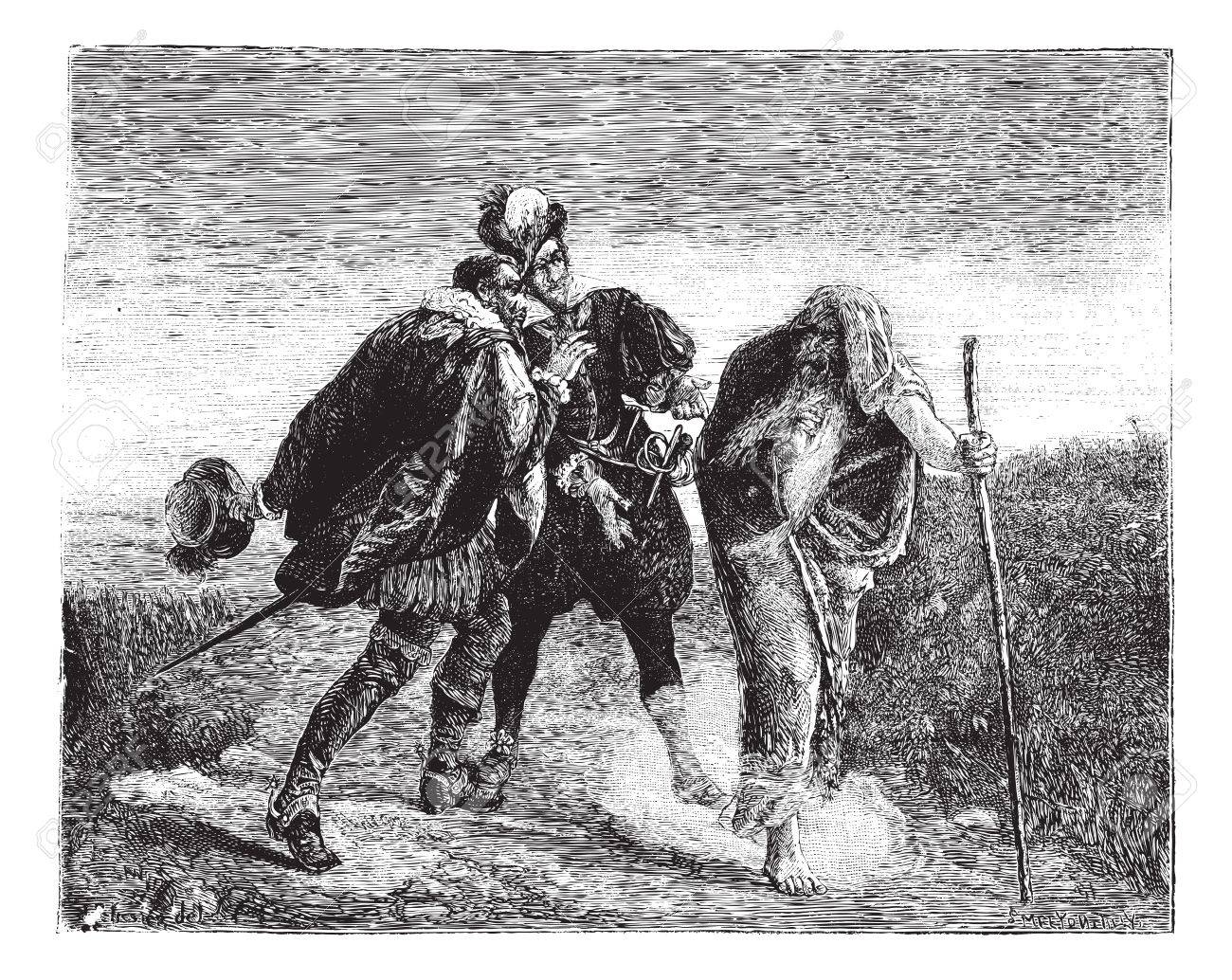

 African Americans came to the United States as slaves and were only allowed to grow a small selection of vegetables for themselves. Collards were one of them. While the vegetable is not African in origin, the methods of preparation were. West Africans use hundreds of species of leafy greens and prepare them in ways that maintain their high nutrient content. Enslaved Africans found fewer wild greens here and came to rely on collards, which were brought here by the British. (Depending upon where the slaves were taken from, they may have been familiar with leafy cabbages as in the Middle Ages, cabbages of various sorts were traded into Africa through Morocco and Mali). They are unique among cabbages in that they can continue to produce leaves over their growing season. They can be harvested for months when other vegetables quit in the cold weather. Collards helped slaves to survive due to their productivity. For this reason, poor white people also grew collards. It is a cheap, productive, healthy plant. Although white Southerners grew the plant, it was a marginal crop to European settlers and African Americans deserve credit for popularizing the use of greens and their preparation.
African Americans came to the United States as slaves and were only allowed to grow a small selection of vegetables for themselves. Collards were one of them. While the vegetable is not African in origin, the methods of preparation were. West Africans use hundreds of species of leafy greens and prepare them in ways that maintain their high nutrient content. Enslaved Africans found fewer wild greens here and came to rely on collards, which were brought here by the British. (Depending upon where the slaves were taken from, they may have been familiar with leafy cabbages as in the Middle Ages, cabbages of various sorts were traded into Africa through Morocco and Mali). They are unique among cabbages in that they can continue to produce leaves over their growing season. They can be harvested for months when other vegetables quit in the cold weather. Collards helped slaves to survive due to their productivity. For this reason, poor white people also grew collards. It is a cheap, productive, healthy plant. Although white Southerners grew the plant, it was a marginal crop to European settlers and African Americans deserve credit for popularizing the use of greens and their preparation. 
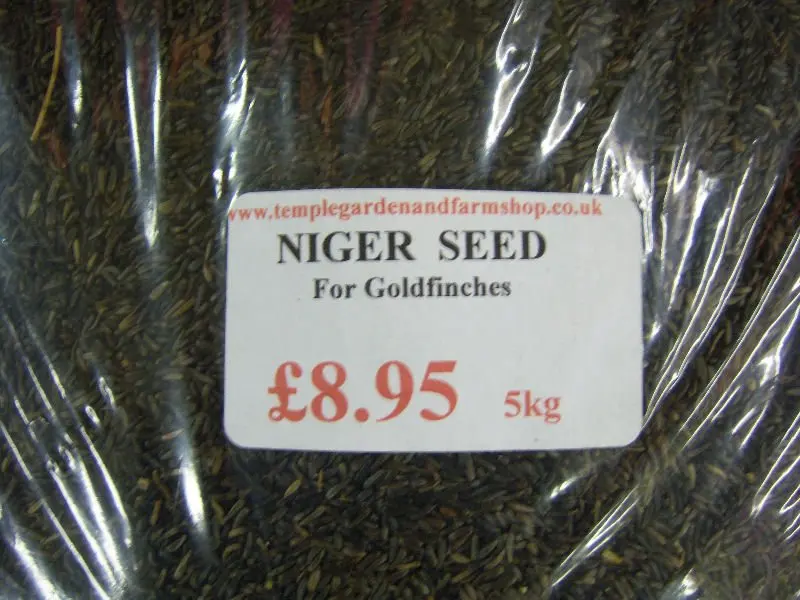 While the name might suggest that the seed came from Nigeria or Niger, nyjer seed actually comes from the Guizotia abyssinica plant which grows in the highlands of Ethiopia. I found a reference to the seed being called Nigerian thistle, which to me indicates that whomever named the seed must have had some confusion about the geography of Africa or, perhaps generically called it “niger” seed as a stand in for Africa itself. Nigeria, Niger, and the Niger River are all located in West Africa whereas Ethiopia is in East Africa. The genus Guizotia contains six species, of which five are native to Ethiopia. A distribution map of the species shows that it grows naturally in some areas of Uganda, Malawi, Ethiopia, Zimbabwe, Tanzania, Democratic Republic of Congo, and Sudan. It also grows in India, Bhutan, Bangladesh, and Nepal. The plants found in and around India are believed to have been brought there long ago by Ethiopian migrants, who also brought millet to the region. Therefore, Nyger seed really has nothing to do with the countries of its (former) namesake and represents a sort of “imagined Africa” rather than any geographical or botanical reality.
While the name might suggest that the seed came from Nigeria or Niger, nyjer seed actually comes from the Guizotia abyssinica plant which grows in the highlands of Ethiopia. I found a reference to the seed being called Nigerian thistle, which to me indicates that whomever named the seed must have had some confusion about the geography of Africa or, perhaps generically called it “niger” seed as a stand in for Africa itself. Nigeria, Niger, and the Niger River are all located in West Africa whereas Ethiopia is in East Africa. The genus Guizotia contains six species, of which five are native to Ethiopia. A distribution map of the species shows that it grows naturally in some areas of Uganda, Malawi, Ethiopia, Zimbabwe, Tanzania, Democratic Republic of Congo, and Sudan. It also grows in India, Bhutan, Bangladesh, and Nepal. The plants found in and around India are believed to have been brought there long ago by Ethiopian migrants, who also brought millet to the region. Therefore, Nyger seed really has nothing to do with the countries of its (former) namesake and represents a sort of “imagined Africa” rather than any geographical or botanical reality. 
